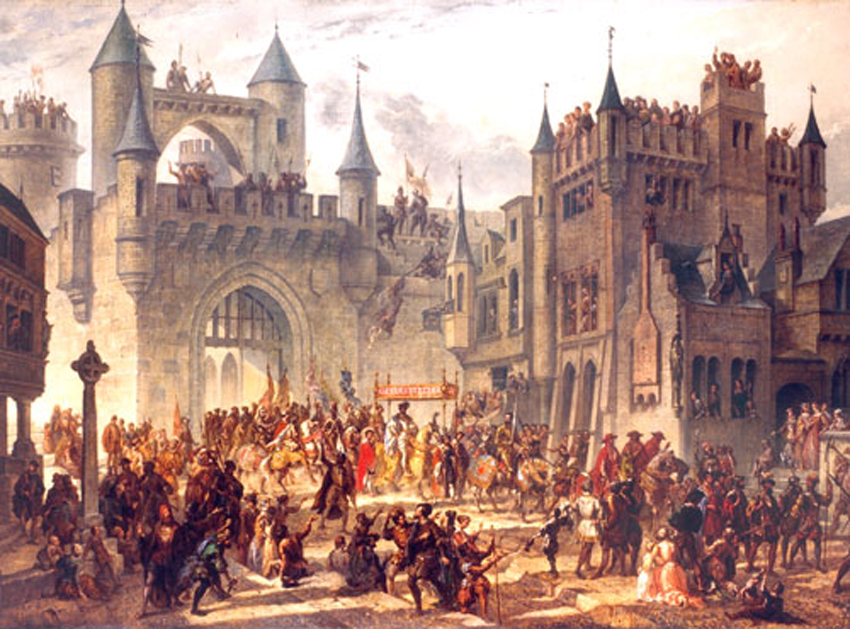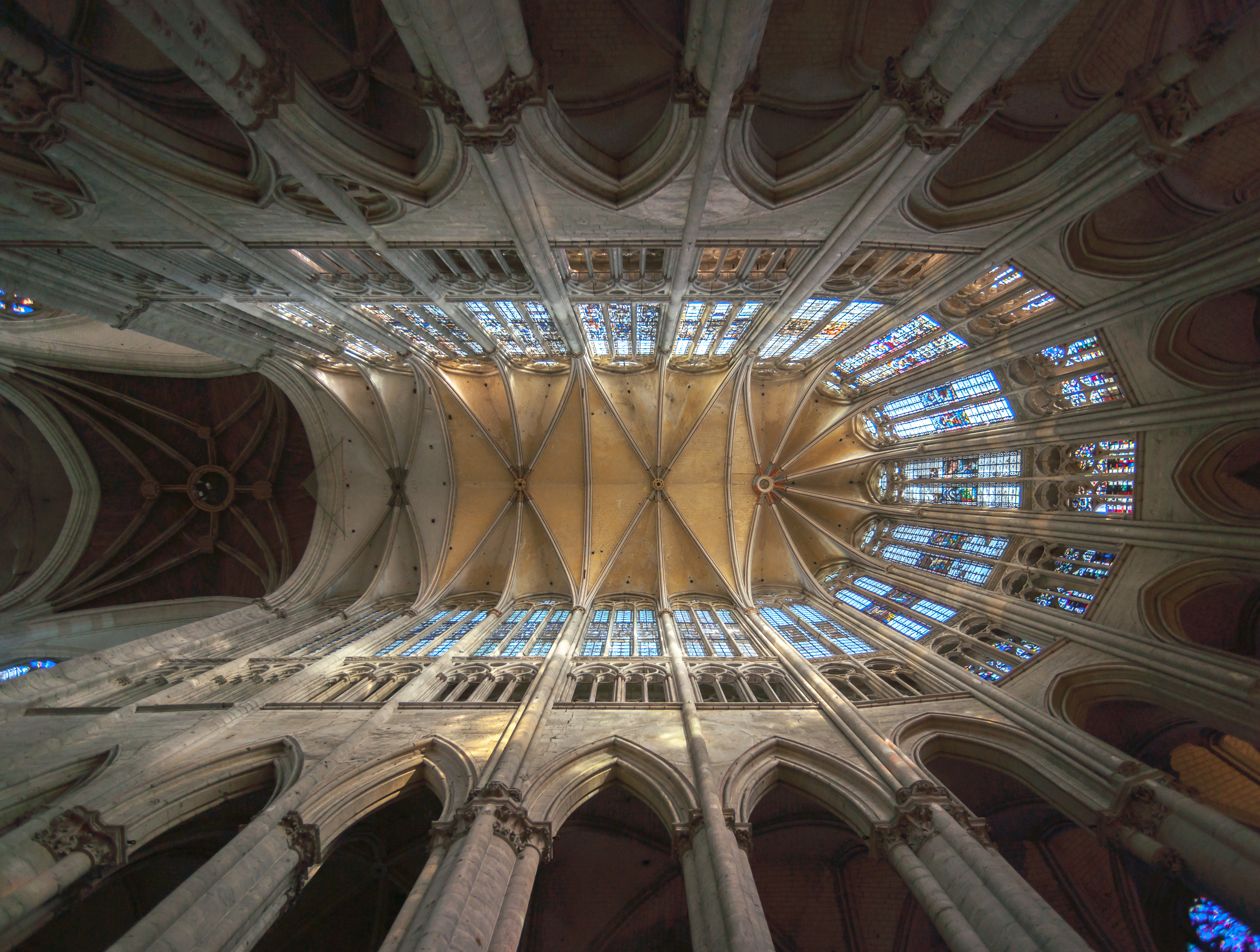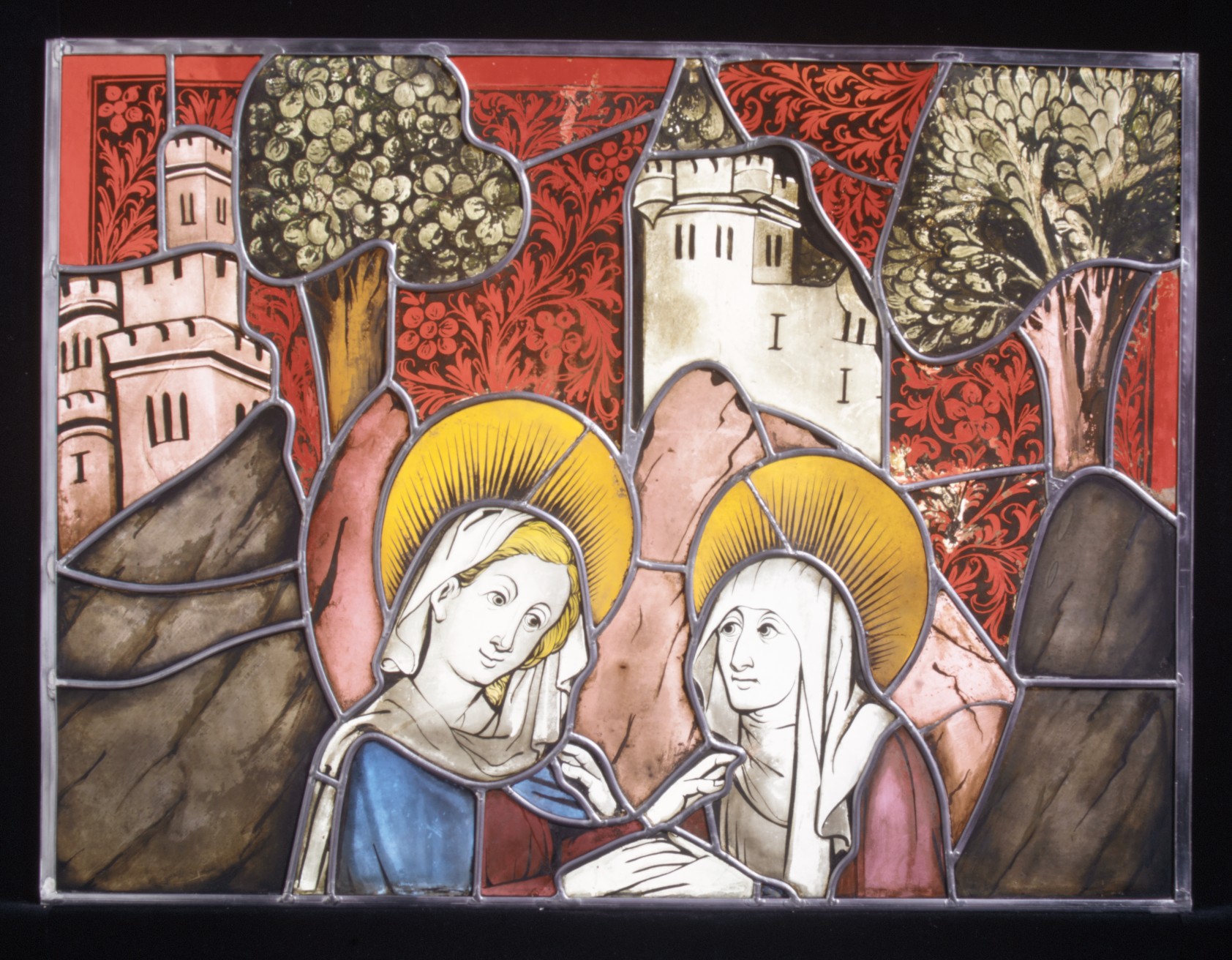|
Metz Cathedral
Metz Cathedral is the cathedral of the Catholic Roman Catholic Diocese of Metz, Diocese of Metz, the seat of the Bishop of Metz, bishops of Metz. It is dedicated to Saint Stephen. The diocese dates back at least to the 4th century and the present cathedral building was begun in the early 14th century. In the mid-14th century, it was joined to the collegiate church of Notre-Dame, and given a new transept and late Gothic chevet, finished between 1486 and 1520. The cathedral treasury displays a rich collection assembled over the long centuries of the history of the Metz diocese and include sacred vestments and items used for the Eucharist. Metz Cathedral has the List of highest church naves, third-highest nave of cathedrals in France (41.41 meters (135.9 ft), after the cathedrals of Amiens Cathedral , Amiens and Beauvais Cathedral, Beauvais. It is nicknamed ("the Good Lord's lantern"), on account of its displaying the largest expanse of stained glass in the world, totalling ... [...More Info...] [...Related Items...] OR: [Wikipedia] [Google] [Baidu] [Amazon] |
Metz
Metz ( , , , then ) is a city in northeast France located at the confluence of the Moselle (river), Moselle and the Seille (Moselle), Seille rivers. Metz is the Prefectures in France, prefecture of the Moselle (department), Moselle Departments of France, department and the seat of the parliament of the Grand Est Regions of France, region. Located near the Tri-border area, tripoint along the junction of France, Germany and Luxembourg,Says J.M. (2010) La Moselle, une rivière européenne. Eds. Serpenoise. the city forms a central part of the European Greater Region and the SaarLorLux euroregion. Metz has a rich 3,000-year history,Bour R. (2007) Histoire de Metz, nouvelle édition. Eds. Serpenoise. having variously been a Celts, Celtic ''oppidum'', an important Gallo-Roman city,Vigneron B. (1986) Metz antique: Divodurum Mediomatricorum. Eds. Maisonneuve. the Merovingian capital of Austrasia,Huguenin A. (2011) Histoire du royaume mérovingien d'Austrasie. Eds. des Paraiges. p ... [...More Info...] [...Related Items...] OR: [Wikipedia] [Google] [Baidu] [Amazon] |
List Of Highest Church Naves
The nave is the central approach to the high altar, the main body of the church, in Romanesque and Gothic Christian abbey, cathedral basilica and church architecture. "Nave" (Medieval Latin ''navis'', "ship") was probably suggested by the keel shape of its vaulting. The nave of a church, whether Romanesque, Gothic or Classical, extends from the entry (which may have a separate vestibule, the narthex) to the chancel and is flanked by lower aisles (definition from Answers.com. Accessed 2010-01.20.) separated from the nave by an . [...More Info...] [...Related Items...] OR: [Wikipedia] [Google] [Baidu] [Amazon] |
Cubism
Cubism is an early-20th-century avant-garde art movement which began in Paris. It revolutionized painting and the visual arts, and sparked artistic innovations in music, ballet, literature, and architecture. Cubist subjects are analyzed, broken up, and reassembled in an abstract form. Instead of depicting objects from a single perspective, the artist depicts the subject from multiple perspectives to represent the subject in a greater context. Cubism has been considered the most influential art movement of the 20th century. The term ''cubism'' is broadly associated with a variety of artworks produced in Paris (Montmartre and Montparnasse) or near Paris (Puteaux) during the 1910s and throughout the 1920s. The movement was pioneered in partnership by Pablo Picasso and Georges Braque, and joined by Jean Metzinger, Albert Gleizes, Robert Delaunay, Henri Le Fauconnier, Juan Gris, and Fernand Léger. One primary influence that led to Cubism was the representation of three-dimensional ... [...More Info...] [...Related Items...] OR: [Wikipedia] [Google] [Baidu] [Amazon] |
Jacques Villon
Jacques Villon (July 31, 1875 – June 9, 1963), also known as Gaston Duchamp, was a French Cubist and Abstract art, abstract painter and printmaker. Early life Born Émile Méry Frédéric Gaston Duchamp in Damville, Eure, Damville, Eure, in Normandy, France, he came from a prosperous and artistically inclined family. While he was a young man, his maternal grandfather Émile Frédéric Nicolle, a successful businessman and artist, educated Villon and his siblings. Gaston Duchamp was the elder brother of: *Raymond Duchamp-Villon (1876–1918), sculptor *Marcel Duchamp (1887–1968), painter, sculptor and author *Suzanne Duchamp, Suzanne Duchamp-Crotti (1889–1963), painter In 1894, he and his brother Raymond moved to Montmartre in Paris. There, he studied law at the University of Paris, but received his father's permission to study art on the condition that he must continue studying law. To distinguish himself from his siblings, Gaston Duchamp adopted the pseudonym of J ... [...More Info...] [...Related Items...] OR: [Wikipedia] [Google] [Baidu] [Amazon] |
Tachisme
__NOTOC__ Tachisme (alternative spelling: Tachism, derived from the French word ''tache'', stain; ) is a French style of Abstract art, abstract painting popular in the 1940s and 1950s. The term is said to have been first used with regards to the movement in 1951.Ian Chilvers (2004''The Oxford Dictionary of Art'' Oxford University Press It is often considered to be the European response and equivalent to abstract expressionism, although there are stylistic differences (American abstract expressionism tended to be more "aggressively raw" than tachisme). It was part of a larger postwar movement known as Informalism, Art Informel (or ''Informel''), which abandoned geometric abstraction in favour of a more intuitive form of expression, similar to action painting. Another name for Tachism is Abstraction lyrique (related to American Lyrical Abstraction). COBRA (avant-garde movement), COBRA is also related to Tachisme, as is Japan's Gutai group. After World War II the term School of Par ... [...More Info...] [...Related Items...] OR: [Wikipedia] [Google] [Baidu] [Amazon] |
Roger Bissière
Roger Bissière (22 September 1886 – 2 December 1964) was a French visual artist and teacher. He designed stained glass windows for Metz cathedral and several other churches; as well as painted, and collaged textiles. Early life and education Roger Bissière was born 22 September 1886 in Villeréal, Lot-et-Garonne. In 1901 the family moved to Bordeaux. His mother, Elisabeth Chastaignol, died 25 April 1902. He started painting at the age of 17. In 1904 his father, Fernand Bissière, did not allow him to enter art school. Roger then travelled to Algeria. From 1905 to 1910, he enrolled at the École Supérieure des Beaux-Arts de Bordeaux where he studied with Paul François Quinsac. Starting in September 1910, he studied with Gabriel Ferrier at the École des Beaux-Arts in Paris. He married Catherine Lucie Lotte (nicknamed ''Mousse''), 23 January 1919. Their son Marc-Antoine was born 15 July 1925. Career Bissière published articles in the magazine L'Esprit ... [...More Info...] [...Related Items...] OR: [Wikipedia] [Google] [Baidu] [Amazon] |
Romanticism
Romanticism (also known as the Romantic movement or Romantic era) was an artistic and intellectual movement that originated in Europe towards the end of the 18th century. The purpose of the movement was to advocate for the importance of subjectivity and objectivity (philosophy), subjectivity, imagination, and appreciation of nature in society and culture in response to the Age of Enlightenment and the Industrial Revolution. Romanticists rejected the social conventions of the time in favour of a moral outlook known as individualism. They argued that passion (emotion), passion and intuition were crucial to understanding the world, and that beauty is more than merely an classicism, affair of form, but rather something that evokes a strong emotional response. With this philosophical foundation, the Romanticists elevated several key themes to which they were deeply committed: a Reverence (emotion), reverence for nature and the supernatural, nostalgia, an idealization of the past as ... [...More Info...] [...Related Items...] OR: [Wikipedia] [Google] [Baidu] [Amazon] |
Charles-Laurent Maréchal
Self-portrait on glass Window Charles-Laurent Maréchal (27 January 1801 – 17 January 1887) was a French painter. Biography Maréchal was born of poor parents at Metz in 1801.Maréchal ogeneanet.org/ref> He was brought up as a saddler, but his bent for art took him early to Paris, where during several years he was a pupil of Jean-Baptiste Regnault. In 1825, he returned to Metz, and in the following year exhibited at the Exposition of the Department of the Moselle, a picture of 'Job,' which procured him the first-class silver medal. In 1831, on the visit of King Louis Philippe I to Metz, he presented to that sovereign a picture of his painting entitled 'Prayer', which obtained honourable mention at the salon of the current year. Amongst his remaining paintings in oil are 'Masaccio as a boy,' 'The Harvest,' and the ' Apotheosis of St. Catherine' painted in 1842 for the Metz Cathedral. He, however, eventually abandoned oil, as a vehicle, in favour of pastel, as being better adap ... [...More Info...] [...Related Items...] OR: [Wikipedia] [Google] [Baidu] [Amazon] |
Valentin Bousch
Valentin Bousch (circa 1490 – August 1541) was a Renaissance stained glass glazier and painter from Strasbourg, active in the Duchy of Lorraine and the Republic of Metz. A rarity among stained glass artists, Bousch is seen as one who actively sought to express new ideas in his art, often before they were widely used in the area, revising his method even from one window to the next, to create striking Renaissance effects and a personal style. Life Bousch was born in Strasbourg. The earliest mention of his work is at Saint-Nicolas-de-Port, near Nancy in 1514.Isler-de Jongh, 1998 (p. 1) Bousch was active there from 1514 to 1520, developed a large glass studio and made many windows for the Saint Nicolas basilica. In 1518 he also made windows for the priory church of Varangéville on a command of the Bishop of Metz, John IV of Lorraine. On 25 September 1518, Valentin Bousch became the master glazier of the cathedral of Metz, where most work was done in the years 1520-1528, ... [...More Info...] [...Related Items...] OR: [Wikipedia] [Google] [Baidu] [Amazon] |
Hermann Von Münster
Hermann von Münster (c. 1330 – March 1392) was a German master glassmaker, native of Münster, in Westphalia, and active in Lorraine. Biography Hermman von Münster is actually the first stained glass artist to be mentioned by the archives of the Cathedral chapter of Saint-Etienne of Metz. On August 29, 1381, master Hermann received an annuity of 22 pounds, to pay for its work on the western large window of the cathedral of Metz. His work was supported by Cardinal William Aigrefeuille, legate of the antipope Clement VII, who then reorganized the Chapter of Metz. Three years later, on 2 May 1384, the Cathedral chapter negotiated the price of the "GRANT OZ", the western Rose window with Hermann von Munster. Hermann was still working on the windows of the western facade in December 1384. In August 1385, the Cathedral Chapter borrowed 420 pounds to set the work completed. In 1388, Hermann bought a home in Metz, beside the cathedral, where he died in March 1392. Thanks to his ... [...More Info...] [...Related Items...] OR: [Wikipedia] [Google] [Baidu] [Amazon] |
Renaissance Art
Renaissance art (1350 – 1620) is the painting, sculpture, and decorative arts of the period of European history known as the Renaissance, which emerged as a distinct style in Italy in about AD 1400, in parallel with developments which occurred in philosophy, literature, music, science, and technology. Renaissance art took as its foundation the art of Classical antiquity, perceived as the noblest of ancient traditions, but transformed that tradition by absorbing recent developments in the art of Northern Europe and by applying contemporary scientific knowledge. Along with Renaissance humanist philosophy, it spread throughout Europe, affecting both artists and their patrons with the development of new techniques and new artistic sensibilities. For art historians, Renaissance art marks the transition of Europe from the medieval period to the Early Modern age. The body of art, including painting, sculpture, architecture, music and literature identified as "Renaissance art" was ... [...More Info...] [...Related Items...] OR: [Wikipedia] [Google] [Baidu] [Amazon] |
Gothic Art
Gothic art was a style of medieval art that developed in Northern France out of Romanesque art in the 12th century, led by the concurrent development of Gothic architecture. It spread to all of Western Europe, and much of Northern Europe, Northern, Southern Europe, Southern and Central Europe, never quite effacing more classical styles in Italy. In the late 14th century, the sophisticated court style of International Gothic developed, which continued to evolve until the late 15th century. In many areas, especially Germany, Late Gothic art continued well into the 16th century, before being subsumed into Renaissance art. Primary media in the Gothic period included sculpture, panel painting, stained glass, fresco and illuminated manuscripts. The easily recognisable shifts in architecture from Romanesque to Gothic, and Gothic to Renaissance styles, are typically used to define the periods in art in all media, although in many ways figurative art developed at a different pace. The ear ... [...More Info...] [...Related Items...] OR: [Wikipedia] [Google] [Baidu] [Amazon] |






